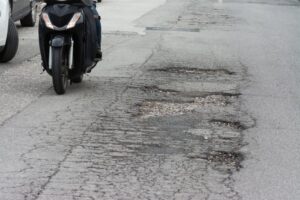If a road hazard was the culprit in your motorcycle accident in Missouri, you might have a path to compensation from the entity responsible for that stretch of road. However, it’s rarely a straightforward fight.
The team at Cook, Barkett, Ponder & Wolz is here to help you cut through the confusion. Give a call to motorcycle crash lawyer at (573) 335-6651 for a no-nonsense discussion about your options.
Whose Job Is It Anyway? Missouri Laws on Road Safety & Maintenance
Recent years have seen a concerning trend: an increase in motorcycle accidents and fatalities. According to the National Highway Traffic Safety Administration (NHTSA), 6,335 motorcyclists were killed in one recent year, making up 15% of all traffic fatalities that year.
Who’s on the hook for that? It’s not as simple as pointing a finger; there’s a whole system of responsibility and, frustratingly, legal protections for the entities in charge.
The Government’s Duty: Keeping Roads Passably Safe
In Missouri, various governmental bodies have a general responsibility to keep public roads in a reasonably safe condition. The Missouri Department of Transportation (MoDOT) is responsible for state highways, which includes over 34,000 miles of road. Counties and cities are typically responsible for local roads within their jurisdictions.
For instance, county highway departments maintain public roads in unincorporated areas that aren’t MoDOT’s responsibility. This duty is outlined in various state statutes, with Missouri Revised Statutes Chapter 227 dealing with the state highway system and Chapter 229 covering county roads.
The Shield of Sovereign Immunity in Missouri (And How to Get Past It)
A significant factor is that, generally, you cannot just sue the government. This principle is called sovereign immunity. However, Missouri law provides some important exceptions. The one most relevant to road hazard claims is the “dangerous condition of property” exception found in RSMo 537.600.1(2). This statute essentially says that if a public entity’s property (like a road) is in a dangerous condition, and that condition causes an injury, sovereign immunity might not apply. This is often the legal doorway for pursuing a claim.
“They Knew or Should Have Known”: The Critical Element of Notice
Just because a road is dangerous doesn’t automatically mean the government entity is liable. A massive part of these cases, as dictated by RSMo 537.600 and developed through case law, is proving “notice.” This means you generally have to show that the entity responsible for the road either:
- Actual Notice: They actually knew about the specific dangerous condition (e.g., someone reported that giant pothole).
- Constructive Notice: They should have known about the dangerous condition because it existed for such a length of time that, through reasonable inspection and maintenance, they should have discovered and fixed it.
And, on top of that, they must have had a reasonable amount of time to correct the hazard after having notice.
Time Limits and Red Tape: Don’t Sleep on Your Rights
Missouri has a general statute of limitations for personal injury claims, which is five years under RSMo 516.120. However, when you’re dealing with government entities, things get trickier. There are often much shorter notice of claim deadlines. These deadlines require you to formally notify the government body of your intent to make a claim, sometimes within as little as 90 days of the incident. These are set by municipal charters or local ordinances. Missing this initial notice deadline will completely bar your claim, regardless of the five-year statute of limitations, so acting quickly is crucial.
The Legal Gauntlet: Breaking Down Liability in Road Hazard Motorcycle Wrecks
Now you know there’s a sliver of a chance to hold them accountable. So, how do you actually prove they dropped the ball and owe you for your trashed bike and aching body? It boils down to proving negligence.
The Four Ingredients for a Negligence Claim
To make a successful negligence claim against the entity responsible for the road, you generally need to prove four things:
- Duty: As we’ve covered, the government entity responsible for the road had a legal duty to maintain it in a reasonably safe condition for ordinary travel.
- Breach: They failed in that duty. This could be anything from not repairing a known, dangerous pothole to leaving debris on the road after construction or failing to warn of an unavoidable hazard.
- Causation: This is a big one. You have to show that their failure—their breach of duty—directly caused your accident and the injuries you suffered. The hazard must be the reason you crashed, not merely present at the scene.
- Damages: You must have suffered actual harm. This includes physical injuries (medical bills, pain), financial losses (lost wages, damage to your motorcycle), and potentially emotional distress.
Essentially, negligence means someone didn’t act with reasonable care, and that lack of care hurt you.
What Counts as a “Road Hazard” Legally?
A “road hazard” takes many forms, extending beyond obvious craters in the pavement. Common examples that could lead to a claim include:
- Potholes, particularly large or deep ones.
- Severe cracks or pavement upheavals.
- Unmarked obstructions on the road surface.
- Loose gravel, sand, or other debris, especially if left by road crews.
- Oil slicks or other slippery substances not promptly addressed.
- Inadequate or missing warnings for construction zones or known hazards.
- Malfunctioning traffic signals if the malfunction is due to negligent maintenance by the responsible entity.
- Poor road design or shoulder drop-offs that create an unsafe condition.
What if You Were Also a Little Bit at Fault? Missouri’s “Pure Comparative Fault”
Realistically, sometimes accidents aren’t 100% one person’s fault. What if, say, the pothole was there, but maybe you were going a tad over the speed limit? Missouri follows a “pure comparative fault” rule, as outlined in RSMo 537.765. This means that even if you are found partially at fault for your accident, you still recover damages from the other at-fault party (like the government entity responsible for the road).
Practical Steps and What to Realistically Expect
You’ve been through a rough experience, and now you’re looking at a potential legal fight on top of healing and repairs. It’s a lot. Let’s break down some practical steps and manage expectations.
First Moves After a Road Hazard Wipes You Out
Assuming you’ve handled the immediate aftermath at the scene (medical attention, police report if called), here’s what to focus on once you’re able to:
- Prioritize Medical Attention: It is crucial to get checked out thoroughly, even if you think you’re “okay.” Some injuries aren’t immediately obvious. Follow all medical advice and keep records of everything.
- Get a Copy of the Police Report: If law enforcement was at the scene, get the official report as soon as it’s available. It often contains valuable initial observations.
- Document Everything Meticulously:
- The Hazard: If it’s safe to do so and the hazard still exists, go back and take clear photos and videos from multiple angles and distances. Include a reference object (like a ruler or your boot) to show scale if it’s a pothole or crack.
- The Scene: Take pictures of the general accident area, any skid marks, debris, and the road conditions
- Your Injuries: Photograph your injuries as they progress (bruises, cuts, casts, etc.).
- Your Bike: Document all damage to your motorcycle and any damaged gear (helmet, leathers, etc.).
- Gather Witness Information: If anyone saw the accident or knows about the hazard (e.g., a local resident who’s seen it for weeks), get their contact details. Their statements are often very helpful.
- Preserve Evidence: Don’t rush to repair your motorcycle if it’s a key piece of evidence. The damage itself tells a story. Similarly, keep your damaged helmet and gear.
- Officially Report the Hazard: Report the specific dangerous condition to the correct government entity (e.g., MoDOT for state highways, the city public works department for a city street). Do this in writing (email or certified letter) if possible, and keep a copy of your report and any response. This is often important for proving “notice.”
What Kind of Compensation Are We Talking About?
If your claim is successful, you may recover compensation for various losses, generally categorized as:
- Economic Damages: These are tangible, calculable losses, such as:
-
- Medical bills (past, current, and future related to the accident).
- Lost income and wages (if you couldn’t work).
- Future lost earning capacity (if your injuries prevent you from returning to your previous job or earning potential).
- Repair or replacement costs for your motorcycle and damaged gear.
- Rehabilitation and therapy costs.
- Non-Economic Damages: These are for intangible losses, which are harder to put a price tag on but are very real, including:
-
- Pain and suffering.
- Emotional distress and mental anguish.
- Loss of enjoyment of life (if you can no longer do activities you once loved).
- Disfigurement or scarring.
The Helmet Issue in Missouri: Does It Tank Your Claim?
Missouri has a somewhat unique helmet law. RSMo 302.020.10 generally requires riders under 26 and those with an instruction permit to wear a helmet. Riders 26 and older can opt-out if they have proof of health insurance coverage.
So, how does this affect your road hazard claim? If you were legally required to wear a helmet and didn’t, or if you opted out but didn’t have the required insurance, it complicates things. Even if you were legally compliant by not wearing a helmet (e.g., over 26 with insurance), the defense might argue that not wearing one contributed to the severity of your head injuries, if you sustained any. This wouldn’t necessarily stop your claim against the entity for causing the hazard itself, but it reduces the amount of damages you recover for head injuries under Missouri’s comparative fault rules.
Why These Cases Are a Grind
Pursuing a claim against a government entity for a road hazard is rarely a walk in the park. Here’s why:
- Proving Notice: This is often the biggest hurdle. Digging up evidence that the city or state knew, or should have known, about that specific loose gravel or that particular sinkhole takes work.
- Sovereign Immunity Complexities: Even with the “dangerous condition” exception, navigating the ins and outs of sovereign immunity and ensuring all procedural requirements are met is complex.
- Strict Deadlines: Those short notice of claim deadlines are unforgiving. Miss one, and your case could be over before it starts.
- Dealing with Government Lawyers: Government entities have lawyers whose job is to protect the public purse, meaning they will vigorously defend against claims and try to minimize payouts.
- Evidence Collection: Properly documenting the hazard, your injuries, and gathering all necessary records and witness statements is a massive undertaking, especially when you’re trying to recover.
This isn’t to say it’s impossible, but it highlights why having someone who understands the system on your side is practically a necessity in these cases.
Road Hazard Got You Down? Cook, Barkett, Ponder & Wolz Will Help You Fight Back.
If you’re staring down the barrel of medical bills and a wrecked bike because of a road hazard in Missouri, don’t go it alone. The team of personal injury lawyers in Cape Girardeau, MO at Cook, Barkett, Ponder & Wolz is ready to hear your story and explain how we are prepared to help.
Call us at (573) 335-6651 for a clear, straightforward assessment of your case.





